|
|
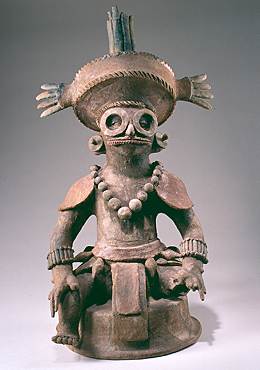
|
Early Classic Maya rulers often used the icons and architectural styles of Teotihuacan in distant Central Mexico to convey their authority, based on actual or perceived connections to that powerful metropolis. K'inich Yax K'uk' Mo', the founder of Copan's ruling dynasty, is always shown with large rings around his eyes, ornaments that typify the Central Mexican storm god.
Censer lid portraying Yax K'uk' Mo' . |
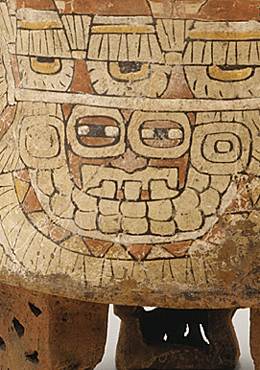
|
This tripod vessel from Teotihuacan presents the image of a warrior dressed as the Central Mexican storm god, who is also associated with warfare. The warrior's eyes are surrounded by the same large circles as seen in the portrait of K'inich Yax K'uk' Mo'.
Tripod Vessel with Image of Warrior Dressed as Tlaloc. |
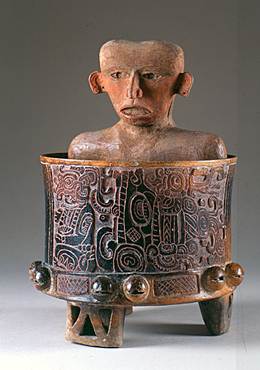
|
This vessel was part of a dedication cache deposited during the construction of a new building atop the ruins of an older structure at Becan in Campeche, Mexico. The figure incised on the vessel resembles the Maya rain god Chaak. He sits in front of the sacred "jade mountain," the origin of precious things such as rain. When it was found, the vessel conatined a Teotihuacan-style hollow figure.
Tripod Vessel with Human Figure |
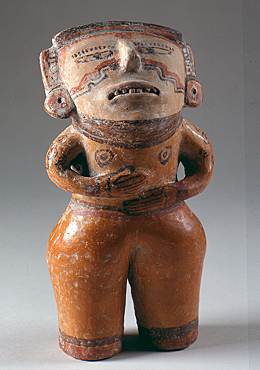
|
This hollow painted figurine was found cradled in the arms of a young woman interred at Yaxuna, a site near Chichen Itza in northern Yucatan. The tomb contained the remains of eleven other individuals — men, women, and children — perhaps members of the site's Early Classic ruling family who may have been assassinated.
Figurine (La Muñeca) |
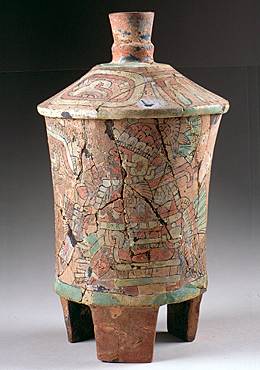
|
Artifacts from Mounds A and B at the Guatemalan site of Kaminaljuyu imply intimate contact with Teotihuacan during the latter decades of the fourth century. This lidded tripod vessel shows a king seated on a throne. Though dressed in Teotihuacan style, with spangled headdress, back mirror, and feather panache, the figure wears Maya-style jadeite jewelry.
Tripod Vessel with Image of Two Plumed Jaguar Heads. |
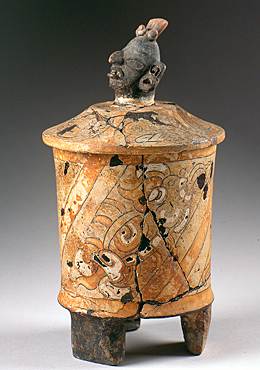
|
Evidence of interaction with Teotihuacan is especially noted in late-fourth-century royal burials at Copan and Tikal, which were furnished with Teotihuacan-style ceramics. At Tikal, Burial 10 contained the remains of Yax Nuun Ayiin I, who took the throne in AD 379 and died on June 17, 404. Among the offerings in his tomb was this lidded tripod vessel.
Tripod Vessel with Maya Hieroglyphs. |
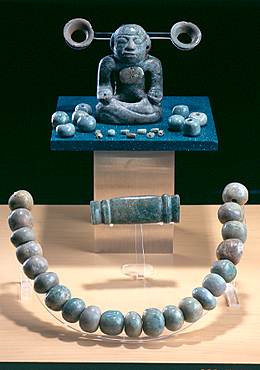
|
Burial 5, inside Teotihuacan's Pyramid of the Moon, was found to contain three high-ranking individuals. Isotopic analysis of their skeletal remains indicates they were from the southern highlands of Guatemala. They were buried in a seated position, and the form and iconography of the jewelry they wore indicate a Maya origin and substantiate the isotopic signatures. A cache in the center of the tomb contained the seated jadeite figurine in this photograph.
Seated Figure with Pectoral, Necklace, and Earflares
Proyecto Pirámide de la Luna (INAH/Aichi Prefectural University/Arizona State University)
|
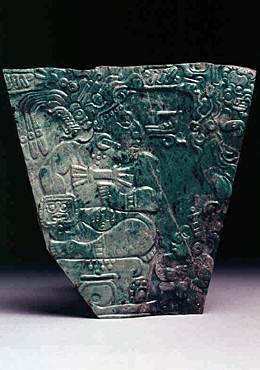
|
This portrait plaque was found in a field near Teotihuacan in the 1930s. It depicts a sacred king, who wears a Jester God jewel and is seated on an altarlike throne. The plaque was probably a royal jewel, and its presence at Teotihuacan implies high-level contact between the two cultures, much like that indicated by Burial 5. The plaque's edges were re-carved in antiquity and a new suspension hole was drilled through its upper end.
Plaque Portraying Seated King and Attendant |
top home |
Copyright 2005 Los Angeles County Museum of Art